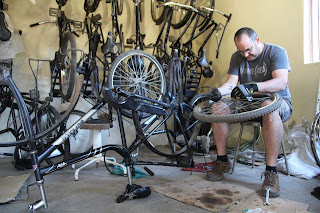Bonjour à tous!
Nous avons passés
la journée à Harare avec notre guide touristique et par ailleurs ami de la
famille qui connait la ville comme sa poche.
A l'heure
actuelle sévi une crise monétaire importante dans le pays qui fait craindre une
récession pire qu'en 2007 quand Michelle était au Zimbabwe. Les banques ferment
leurs guichets automatiques et les montants d'argent que l'on peut retirer
diminuent de semaine en semaine. Au moment où j'écris ses quelques lignes le retrait
maximum est de $100 par jour et par quand l’on peut trouver une banque ayant
des liquidités et des files d'attentes de 2-3 heures apparaissent au gré des
rumeurs qui annoncent que tel ou tel guichets on des fonds. Le gouvernement
vient d'annoncer le lancement de "bonds" pour le mois d'août afin de
pallier au manque de liquidités ce qui rend la situation encore plus tendue
puisque beaucoup pensent que cela précipitera le pays dans une récession majeur
et durable. Au plus fort de la crise en 2008 nos collègues et amis de l'hôpital
de Karanda se relayaient pour aller en Zambie ou Afrique du Sud pour acheter le
strict nécessaire.
La situation
économique actuelle nous a de nouveau rattrapée lors d’une courte visite dans
un centre commercial à la recherche d’un maillot de l’équipe nationale de
football. Une bonne moitié des magasins sont fermés ou vacant et c’est d’un
centre commercial bien triste que je suis ressorti sans maillot!
A l'aube de
notre départ il semble que le futur proche soit très incertain.
Nyasha (notre
guide) nous a fait passer d'un extrême à un autre en quelques heures. En
premier nous avons visité le (très grand) quartier riche de la capitale.
Michelle et moi avons été surpris de la richesse très apparente, la taille des
maisons, les priorités sécurisées comme l'on en voit aux Etats-Unis et un centre
d'achat construit pour cette clientèle unique. Nous avons visités celui-ci et
nous sommes retrouvés entourés en grande majorité de "blancs" :
Sentiment étrange après plus d’un mois passés à faire partie d'une très petite
minorité. Pour référence les blancs représentent 0.3% de la population zimbabwéenne
en 2015. Nous étions donc dans une sorte de ghetto!
D'un extrême à
un autre nous nous sommes ensuite rendu dans le sud de la ville et sa banlieue
défavorisée. Ici pas de ZEP, ZUP, banlieue prioritaire ou autre abréviation
intelligente comme l’on en voit souvent dans les nouvelles en Europe ces
temps-ci. Seulement une continuité de maisons, immeubles et un environnement
dégradés. Pour la première fois je ne me suis pas senti en contrôle de la
situation et Nyasha était visiblement très nerveux à l'idée de nous avoir dans
sa voiture et encore plus quand nous nous sommes retrouvés piégés dans les
bouchons du bidonville à cause de match de football qui venait de se terminer.
Dans un pays au climat racial tendu et à la situation politique précaire ce
n'était pas forcément l'idée du jour de visiter cette partie de la ville.
J'ai dû me résoudre à ranger mon appareil photo après plusieurs demandes
explicites de Nyasha. Il n'y a eu aucune agressivité physique mais les regards
et les mots parfois virulents à mes tentatives de prendre des photos (même
dérobées) nous ont fait comprendre que la situation pouvait dégénérer à tout
moment.
Nous avons donc
fait profil bas pour le reste de la traversée, les enfants avec maman derrière
et moi avec Nyasha devant évitant tout regard direct. Un gros mal à l’aise à la
sortie du quartier pas à cause de la situation mais de voir tant de pauvreté à
seulement quelques encablures d’une richesse exubérante qui amplifie l’écart
entre les catégories sociales.
Après discussion
Michelle et moi nous sommes dit que la pauvreté des gens à Karanda n’avait pas
grand chose à voir avec celle que nous venions de voir. Même si les gens de
Karanda semblent très pauvres une grand majorité est en mesure de survivre
cultivant un lopin de terre qui leur permettant ainsi de subvenir aux besoins
de base de leur famille même si, évidemment, cela ne leur permet pas de sortir
de la pauvreté. Nous n’avons pas eu le même sentiment en traversant ce quartier
ou les gens vivent dans une pauvreté extrême, dans des conditions difficiles
quand 3 à 4 familles partagent un appartement de 2 chambres et des conditions
de salubrité qui catégorisent le Zimbabwé comme pays du tiers-monde.
Les quelques
photos ci-dessous parlent pour elles mêmes.
Pour finir la
journée nous sommes allés visiter la Galerie d’art Nationale d’Hararé. Une
visite intéressante pour nous et les enfants qui ont pu se dégourdir les jambes
dans le parc du musée. L’idée originale était de les laissant dans un parc
adjacent avec Nyasha pendant que moi et Michelle faisions le tour du musée. Les
conditions de sécurités dans le parc n’’étaient satisfaisantes et nous sommes
finalement allés en famille au musée. Il
y avait d’ailleurs une petite exposition d’art utilisant des déchets recyclés
comme de bouteilles de verre, des rubans de cassettes vidéos et toutes sortes
d’objets réinventés.
Cette exposition
était intéressante puisqu’elle fait un lien intéressant avec ce que j’ai peu
observé depuis notre arrivée au Zimbabwé et qui se résume par la capacité à
réutiliser et réinventer chaque objet de la vie quotidienne. Dans cette exposition se trouvait un série de
courts documentaires de la BBC, de témoignages d’artistes locaux et
internationaux engagés dans la protection de l’environnement. J’ai été intrigué
par la vidéo de Prince EA P(lien ci-dessous) que je ne connaissais pas
auparavant mais qui – dans le contexte actuel du zimbabwé et de l’Afrique en générale – est intéressante à
regarder.
Je vous laisse la dessus.





























